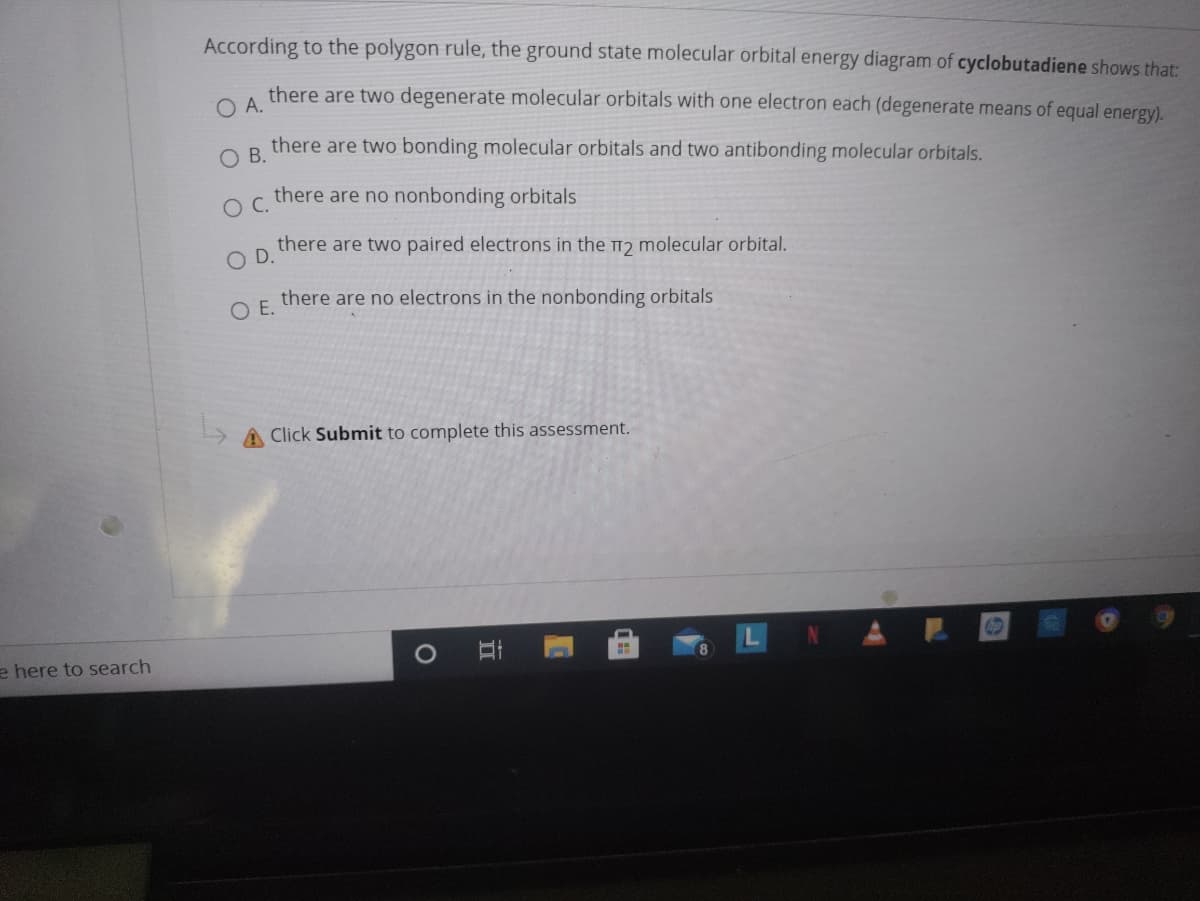According to the polygon rule, the ground state molecular orbital energy diagram of cyclobutadiene shows that: there are two degenerate molecular orbitals with one electron each (degenerate means of equal energy). O A. there are two bonding molecular orbitals and two antibonding molecular orbitals. В. there are no nonbonding orbitals there are two paired electrons in the 12 molecular orbital. OD. O E. there are no electrons in the nonbonding orbitals
According to the polygon rule, the ground state molecular orbital energy diagram of cyclobutadiene shows that: there are two degenerate molecular orbitals with one electron each (degenerate means of equal energy). O A. there are two bonding molecular orbitals and two antibonding molecular orbitals. В. there are no nonbonding orbitals there are two paired electrons in the 12 molecular orbital. OD. O E. there are no electrons in the nonbonding orbitals
Chemistry: Principles and Practice
3rd Edition
ISBN:9780534420123
Author:Daniel L. Reger, Scott R. Goode, David W. Ball, Edward Mercer
Publisher:Daniel L. Reger, Scott R. Goode, David W. Ball, Edward Mercer
Chapter10: Molecular Structure And Bonding Theories
Section: Chapter Questions
Problem 10.101QE: The molecular orbital diagram of NO shown in Figure 10.47 also applies to OF. Draw the complete...
Related questions
Question

Transcribed Image Text:According to the polygon rule, the ground state molecular orbital energy diagram of cyclobutadiene shows that:
there are two degenerate molecular orbitals with one electron each (degenerate means of equal energy).
OA.
O B.
there are two bonding molecular orbitals and two antibonding molecular orbitals.
there are no nonbonding orbitals
there are two paired electrons in the 12 molecular orbital.
OD.
there are no electrons in the nonbonding orbitals
OE.
A Click Submit to complete this assessment.
e here to search
Expert Solution
This question has been solved!
Explore an expertly crafted, step-by-step solution for a thorough understanding of key concepts.
This is a popular solution!
Trending now
This is a popular solution!
Step by step
Solved in 3 steps with 4 images

Knowledge Booster
Learn more about
Need a deep-dive on the concept behind this application? Look no further. Learn more about this topic, chemistry and related others by exploring similar questions and additional content below.Recommended textbooks for you

Chemistry: Principles and Practice
Chemistry
ISBN:
9780534420123
Author:
Daniel L. Reger, Scott R. Goode, David W. Ball, Edward Mercer
Publisher:
Cengage Learning

Chemistry & Chemical Reactivity
Chemistry
ISBN:
9781133949640
Author:
John C. Kotz, Paul M. Treichel, John Townsend, David Treichel
Publisher:
Cengage Learning

Chemistry & Chemical Reactivity
Chemistry
ISBN:
9781337399074
Author:
John C. Kotz, Paul M. Treichel, John Townsend, David Treichel
Publisher:
Cengage Learning

Chemistry: Principles and Practice
Chemistry
ISBN:
9780534420123
Author:
Daniel L. Reger, Scott R. Goode, David W. Ball, Edward Mercer
Publisher:
Cengage Learning

Chemistry & Chemical Reactivity
Chemistry
ISBN:
9781133949640
Author:
John C. Kotz, Paul M. Treichel, John Townsend, David Treichel
Publisher:
Cengage Learning

Chemistry & Chemical Reactivity
Chemistry
ISBN:
9781337399074
Author:
John C. Kotz, Paul M. Treichel, John Townsend, David Treichel
Publisher:
Cengage Learning

Organic Chemistry: A Guided Inquiry
Chemistry
ISBN:
9780618974122
Author:
Andrei Straumanis
Publisher:
Cengage Learning

Chemistry: The Molecular Science
Chemistry
ISBN:
9781285199047
Author:
John W. Moore, Conrad L. Stanitski
Publisher:
Cengage Learning

Chemistry: An Atoms First Approach
Chemistry
ISBN:
9781305079243
Author:
Steven S. Zumdahl, Susan A. Zumdahl
Publisher:
Cengage Learning